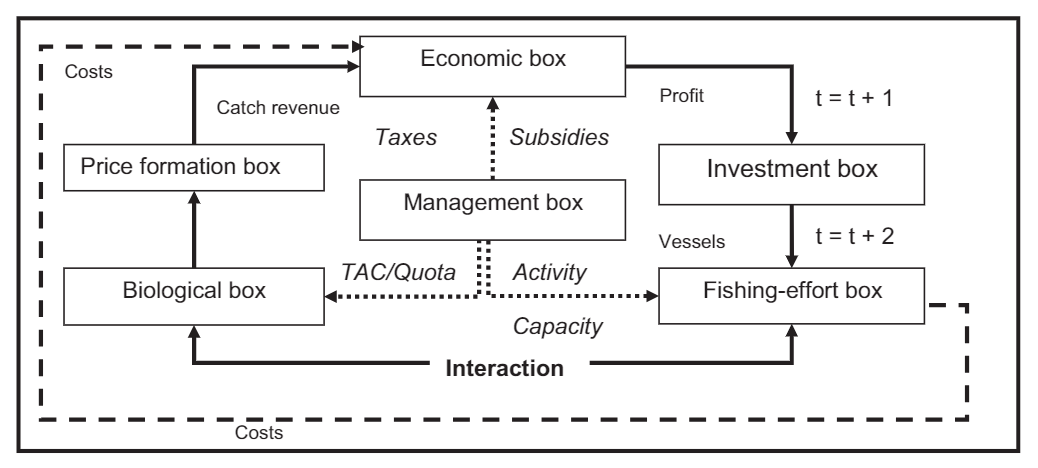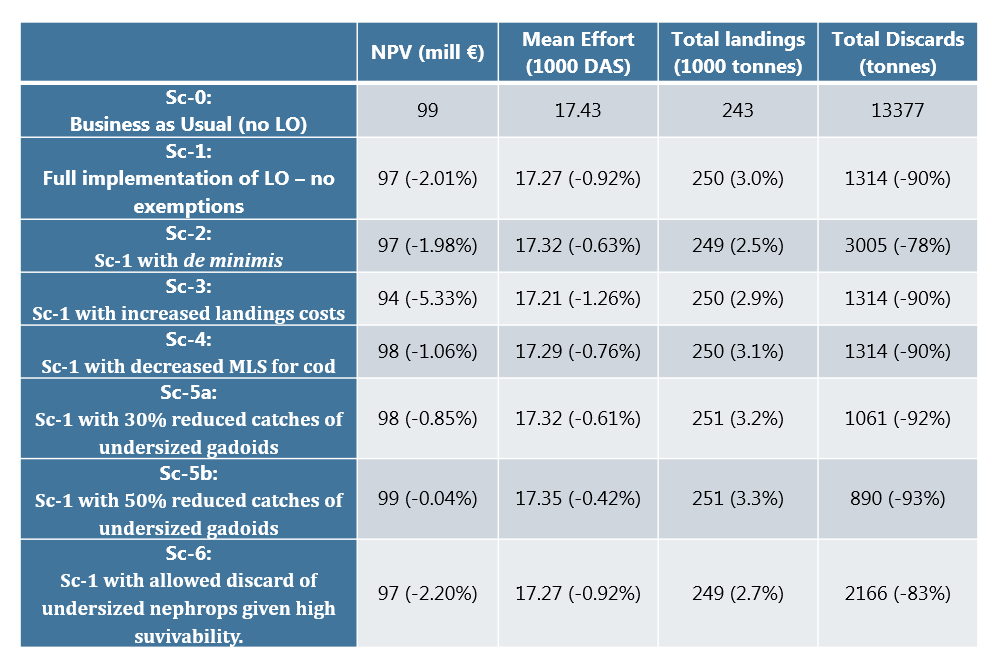

The Danish North Sea Demersal Fishery
The Danish North Sea (NS) fishery constitutes a major part of the total Danish fishery; In 2012-2014 this fishery harvested 68% of the total value produced by the Danish fishery. The landings of demersal species constituted 25% of the total landed value from the NS in the same period. 10 fleet segments has been identified for which the value of landed demersal species caught in the NS constituted more than 20% of their total landed value in 2012-2014. As such it is expected that the implementation of the LO in area IV will have a significant influence on these segments’ economy. These 10 fleet segment have been the focus of the analysis.
Model used
The Danish NS demersal fishery has been analysed using Fishrent, a bio-economic model that integrates the economy and the biology of a fishery. The structure of Fishrent is described in Salz et al. (2011) and Frost et al. (2013). Fishrent integrates the following components: (i) recruitment of fish-stocks (through mass balance modelling), (ii) fishing technology, (iii) economic behaviour of fishers, (iv) management that can be both input (effort) and output (landings/catch) driven, and (vi) price formation. In the Danish NS demersal fishery case Fishrent operates at a monthly basis over a period of 10 years (2016-2025).
It should be noted that the economic benefits estimated in all cases must be expected to be overestimated in proportion to what could be achieved in a real fishery because it is in the present context assumed that there is full information in the fishery, no market failures and no transaction costs at the exchange of quotas. However, as these assumptions apply both to the base case and the LO scenarios, the changes shown for the scenarios compared to the base case are considered robust.

Figure from Frost et a. (2013)
Conclusion :
The analysis suggests that introducing the LO will not have a considerable negative effect for the Danish NS demersal fleet as a whole and that some fleet segments may even benefit from the LO, if it is possible to sell previously discarded undersized fish at prices for fish for reduction. However, this result relies on the Danish ITQ regulation system, i.e. that fleets can trade/lease quotas in order to avoid choking. And, in spite of the ITQ system in place, the large trawlers 24-40 meters for human consumption are predicted to have a decrease of in NPV over the period 2016-2025, given the LO, if no exemptions or mitigation strategies are in order.
These effects are also reflected in the quota utilisations, landings and efforts experienced by the fleet segments. Effort is almost not influenced by the introduction of the LO (except for the large demersal trawlers). Quota utilisation is for most species improved, landings higher, and discards reduced with the LO implemented.

Sources : Ayoe Hoff, IFRO. Numbers in parenthesis are percentage change relative to Sc-0 – no Landings Obligation.
Thus, even though the LO is not predicted to have overall significant negative economic consequences for the Danish fishery, individual fleet segments may still experience losses, that can possibly be remedied through migigation or avoidance strategies, as proposed in WP3-7 of Discardless.
See also
Frost, H., P. Andersen, A. Hoff. 2013. “Management of Complex Fisheries: Lessons Learned from a Simulation Model.” Canadian Journal of Agricultural Economics 61:283–307.
Salz P., E. Buisman, K. Soma, H. Frost, P. Accadia and R. Prellezo 2011.” FISHRENT – Bio-economic simulation and optimization model for fisheries.” LEI-Report 2011-024.
Citation :
Fiche Danish fleets, Author(s) : Ayoe Hoff, IFRO
DiscardLess (2019) : Bioeconomic models to analyse LO effects